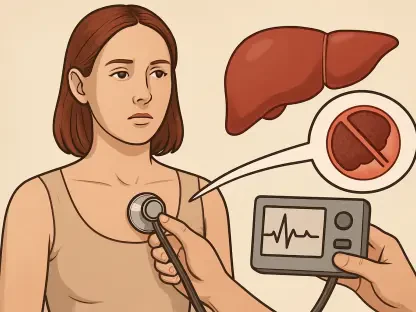The Deep South of the United States, famously known for its rich cultural tapestry, also faces endemic health challenges, with heart disease standing as the leading cause of death. States like Alabama, Georgia, Louisiana, Mississippi, and South Carolina have been at the center of attention for this critical health issue. Recent studies have been diving deep into the intricate web of socio-economic and environmental elements that elevate heart disease risks in this region. As technological reforms like telehealth rise in popularity, understanding how these advances can interplay with traditional healthcare methods becomes crucial. Furthermore, examining the role of social factors, such as access to healthcare professionals and community support, paints a comprehensive picture of addressing heart health disparities in these regions.
The Landscape of Cardiovascular Health
Unraveling Key Contributors to Heart Disease
A landmark study led by University of Mississippi professors delves into how various non-medical factors significantly shape heart disease outcomes in the Deep South. By analyzing 418 counties, the research identifies key social, environmental, and infrastructural elements influencing coronary heart disease (CHD) risks. The availability of healthcare providers surfaces as a crucial determinant. Profound evidence shows that counties with higher numbers of primary care physicians experience lower mortality rates due to heart disease. Thus, even slight enhancements to the healthcare workforce can yield noticeable improvements in cardiovascular health, underscoring the effectiveness of initiatives like loan forgiveness programs for rural healthcare workers.
Aside from professional healthcare access, the presence of community health workers and telehealth resources also plays a pivotal role. The study highlights how even counties plagued by severe socio-economic hardships see positive health impacts when supported by these resources. Exemplifying this, counties like Washington County, Alabama, and Treutlen County, Georgia, showcase how committed, state-supported efforts can catalyze health improvements in structurally disadvantaged communities. The correlation between community presence and heart disease mitigation emphasizes the broader benefits of a multifaceted approach that blends traditional healthcare accessibility with emerging telehealth solutions.
Socio-Economic and Technological Disparities
The narrative drawn from the research emphasizes how socio-economic conditions, digital divides, and lifestyle elements contribute markedly to health disparities among counties studied. While telehealth introduces an innovative frontier for healthcare, the solitary reliance on technology is insufficient to resolve deep-seated healthcare access issues. A more viable model might involve harmonizing digital support with tangible healthcare infrastructure, which better aligns with rural community setups. The analysis asserts that without addressing these socio-economic disparities, even the most advanced technological interventions may fall short of the desired outcomes.
The disparity in healthcare outcomes between rural and urban areas stands as a prevailing trend influenced significantly by systemic health and social inequities. Poor access to healthcare providers, digital resources, and economic barriers predominantly afflict rural residents in these southern states. Here, telehealth emerges as a potential bridge; however, its effectiveness hinges on the strength of existing local healthcare and community support systems. Addressing these inequities requires an approach that not only expands healthcare technology but reinforces it with foundational healthcare and socio-economic support.
Innovative Strategies and Models
Learning from Resilient Regions
An intriguing approach highlighted in the study involves learning from resilient regions known for their robust social and healthcare networks. Denver, Colorado, emerges as an example where well-established community and healthcare support contribute to improved health outcomes. As a potential model, examining and emulating the successful strategies from such regions can provide a blueprint for the Deep South. The study suggests leveraging insights from these regions to foster scalable community-driven strategies focused on health equity across the southern states.
By drawing knowledge from resilient counties, these less fortunate regions can aspire to adapt and replicate effective methods, thereby bridging the gap in heart health outcomes. Such adaptations can manifest through initiatives aimed at ensuring access to essential healthcare services and facilitating community efforts that nurture cardiovascular wellness. Moreover, strengthening local economies through health investments holds potential for broader socio-economic benefits, contributing to the overall well-being of residents.
Addressing Resource and Workforce Disparities
Research identifies uneven distribution of healthcare resources across counties as a fundamental challenge needing redress. Certain areas, such as the Mississippi Delta, suffer from disproportionately high rates of CHD mortality due to factors like poverty and a shortage of healthcare workers. Addressing this requires targeted investment in healthcare infrastructure aimed at increasing provider availability and patient access. With projections indicating Mississippi alone needing 364 more primary care providers by 2030 to meet growing demands, urgent calls for expansion of healthcare services are evident.
Such strategic investments prove vital not merely for boosting health outcomes but also for ensuring economic sustainability. Increased healthcare workforce and enhanced access to care services benefit not only physical health but invigorate local economies by fostering job creation and reducing healthcare-associated financial strains. With proper resources and policies, these rural southern regions can mitigate expansive health inequalities, addressing the critical heart health challenges they face.
Path Forward and Future Considerations
Comprehensive Framework for Heart Health
The study offers a compelling narrative about how varied circumstances across counties encode unique challenges and solutions for heart health. Emphasizing that rural areas are not a monolithic entity, it accentuates the necessity of recognizing distinct inadequacies and developing bespoke strategies. Comprehensive health infrastructures can be built by cross-referencing successful case studies from resilient regions to inform policy decisions and intervention plans in the Deep South.
Data and analysis shed light on the indispensable roles of both technology and healthcare access in influencing health outcomes. These elements must integrate with substantial social support systems to ensure efficacy. Investments oriented towards social, economic, and systemic changes in rural healthcare are essential for reducing health inequalities prevalent across myriad counties in these southern states.
Leveraging empirical data and real-world examples, the study fosters optimism that with strategic initiatives, even the most disadvantaged populations can see progressive enhancements in heart health. Approaches highlighting sectoral collaborations, resilient community practices, and strategic investments convey that pathways for improving cardiovascular health look promising, albeit challenging.
Implications for Public Health Policies and Programs
University of Mississippi professors led a significant study exploring how non-medical factors impact heart disease outcomes in the Deep South. Analyzing 418 counties, the research identifies key social, environmental, and infrastructural elements that affect coronary heart disease (CHD) risks. The availability of healthcare providers is a major factor; evidence reveals that counties with more primary care physicians have lower heart disease mortality rates. Thus, even minor enhancements to the healthcare workforce can significantly improve cardiovascular health, making initiatives like loan forgiveness programs for rural healthcare workers invaluable.
Besides professional healthcare access, the presence of community health workers and telehealth resources is crucial. The study emphasizes that even counties facing severe socio-economic challenges benefit when these resources are available. For instance, Washington County, Alabama, and Treutlen County, Georgia, demonstrate how dedicated, state-backed efforts can improve health in disadvantaged communities. This correlation highlights the broader benefits of blending traditional healthcare access with innovative telehealth solutions.









